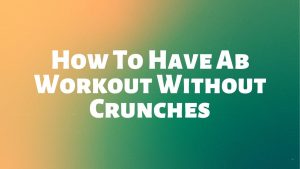To build lean muscle and recover faster after an ab workout, consume the right foods in proper proportions. Unless you had a substantial pre-workout meal, aim to eat your post-workout meal within an hour of working out, and no later than two hours after working out if you did.
If you need assistance creating post-workout meals that will help you achieve your fitness goals, consult with a sports nutritionist.
When you engage in any type of intense workout, your body utilizes a variety of nutrients. This is your body’s ammunition.
After you’ve completed your abdominal regimen, it’s time to replenish your body. If you do not consume food or liquids following workouts, your body enters a “saving” mode and stores, for example, fat. That is not what we want, which is why eating the correct foods following your workout is critical.
Consume Enough Protein, but Not Too Much of It
Men need 40-60 grams of protein from two palm-sized servings, while women need 20-30 grams from one palm-sized serving as an ideal post-workout meal. Lean meats such as beef, pork, poultry, and tofu, along with beans and legumes and eggs and egg substitutes, are all good options.
Grilling, roasting, or broiling is preferable to frying when it comes to fatty cuts of meat.
Include Carbohydrates in Your Diet
Glycogen stores are depleted during exercise and can be rebuilt with carbohydrates in your post-workout meal. Choose fresh produce, low- or nonfat dairy, and whole grains like brown rice, oatmeal, barley, quinoa, whole-wheat bread, or pasta made from whole grains.
Aim to consume two servings of grains or fruits for men, such as one cup of cooked brown rice and a cup of fresh blueberries, along with two servings of vegetables, such as steamed or stir-fried broccoli, carrot, onion and bell pepper.
Vegetables and carbohydrate-rich foods should each be served to women in the amount of one serving each.
Reduce Your Consumption of Fats
It’s important to have a moderate amount of mono- and polyunsaturated fat in your post-workout meal in order to better absorb nutrients like vitamins A, E, and K, which are fat-soluble. Use olive oil to sauté your vegetables or dress a salad with an olive oil-based vinaigrette.
Make a whole-wheat avocado sandwich or vegetable omelet with thin slices of ripe avocado. Fatty fish like salmon or tuna can be grilled, nut butter can be spread on celery or apple slices, or you can simply eat a handful of nuts.
Avoid trans-fat-containing foods such as butter, lard, and full-fat dairy products.
Drink Water to Rehydrate Your Body
Hydrate well after a workout to prevent dehydration. Not drinking enough fluids increases your risk of becoming dehydrated, which will leave you unable to perform as well in your next workout. If you do this, your performance and progress may be slowed.
Drink at least 2 cups of fluid with your post-workout meal and even more if you worked out hard enough to lose several pounds through perspiration.
Don’t stop drinking water until you’ve finished the day.
Top foods to include in a diet for abs
Several foods that are high in protein or healthy fats include the following:
- Fowl, such as chicken and turkey; lean meats, such as cattle, hog, and lamb; and fish, particularly fatty fish such as salmon, which is high in omega-3 fatty acids.
- Dairy products with a low-fat content, such as milk, cheese, and yogurt
- Eggs
- Tofu, beans, or tempeh are all examples of vegetarian proteins.
- The majority of nuts, such as walnuts, almonds, and hazelnuts; and seeds, such as pumpkin, sunflower, and quinoa.
Carbohydrates that can be used to feed the body during exercise include the following:
- A variety of fruits, such as bananas, apples, and oranges
- Non-starchy vegetables such as broccoli, cauliflower, and spinach starchy vegetables such as sweet potatoes, corn, and green peas whole grain bread, brown rice, and oats beans and legumes such as lentils, kidney beans, and chickpeas
Foods to avoid when trying to define the abs
Consuming too many calories, particularly those from sugary or fatty foods, might result in weight gain. As a result, those attempting to define their abdominal muscles may desire to avoid foods with a low nutritional value and a high calorie count.
Some foods to avoid or limit in a diet to define abs include the following:
- Sugar-sweetened foods, such as candy, chocolates, and cakes
- Sugar-sweetened beverages, such as sports drinks, soda, and alcoholic beverages refined carbohydrates, such as white bread, white pasta, and sugary cereals
- Fried foods, which include hamburgers, fries, and fried chicken processed meats, which include pastrami, pepperoni, and hot dogs
A study discovered that a reduced salt diet may help to alleviate stomach bloating. To aid in abdominal definition, an individual may wish to try lowering their intake of salty foods.




